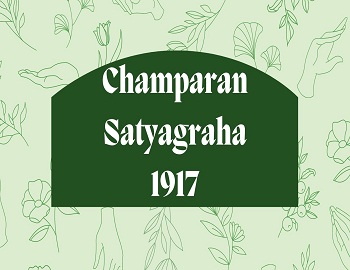Champaran Satyagraha 1917:
The Champaran Satyagraha in 1917 was Gandhi’s first Satyagraha in India. In Champaran- a Permanent Settlement- there were large zamindari estates under rich and influential landlords. Most of the villages were leased out by the zamindars to thikadars of whom the most influential group was European indigo planters. Though the planters were- in law- temporary tenure-holders, they not only realized rent from the peasants but also exercise civil and criminal jurisdiction over them. The result was the reduction of the peasantry, in the words of Gandhi, to an “abjectly helpless” condition.
The peasants of Champaran in North Bihar were growing indigo under tinkathia system (3/20th of their holding for indigo cultivation). The economic impact of the First World War, particularly the rise in prices, added to the normal difficulties of the indigo-cultivating peasantry, such as compulsion for the cultivation of indigo, payment of low prices by the planters, use of force and fraud by them etc. Champaran was ripe for agitation when Gandhi arrived there at the invitation of a local peasant leader Rajkumar Shukla. Through tours in rural areas, he established direct contact with ordinary people and talked about their concerns in the language which they understood. This was a novel political technique, it had never been practised by the educated leaders of the Congress. For the first time, the peasants were drawn into political agitation under a new type of leadership.
Soon after his arrival in Motihari, Gandhi was served with a government order to leave Champaran. When he refused to do so, he was asked to appear on trial for disobeying the government order. Gandhi pleaded guilty and requested the magistrate to try him. Explaining his refusal to leave Champaran, Gandhi said, “I have disregarded the order served upon me not for want of respect for lawful authority, but in obedience to the higher law of our being, the voice of conscience”. The moral challenge thrown to the magistrate perplexed him. Eventually, the case against him was withdrawn and he was permitted to conduct his proposed enquiry. At Champaran, he started recording the statements of the peasants to make sure that they were giving correct information. Impressed by his idealism, young nationalists like Rajendra Prasad, Mazhar-ul-Huq, Mahadev Desai and J. B. Kripalani worked with him in Champaran. As a result of the enquiry, the Government appointed a Commission of Inquiry, of which even Gandhi was a member. The Commission decided to end the tinkathia system and announced that peasants were to be compensated for the illegal enhancement of their dues. Gandhi told the planters to refund only 25% of the money they had taken illegally from the peasants. It was a compromise sign of a great flexible leader. But the political result of the campaign was of immense significance in Gandhi’s career’; it gave him “an all-India public reputation”.









Comments (No)